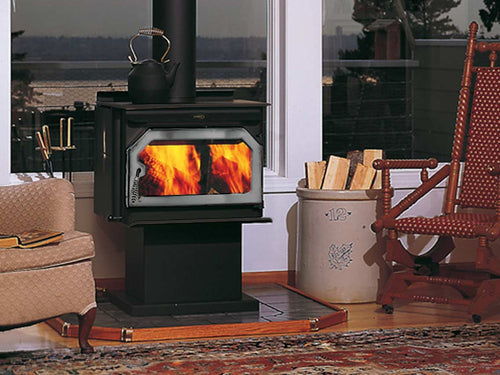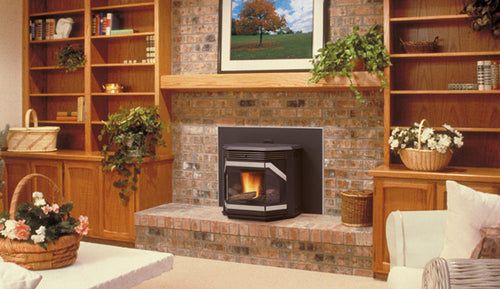Wood stoves have been a popular heating method for centuries, providing warmth and comfort to countless households. They offer a cozy ambiance and can save you money on your heating bills. However, with the rise of alternative heating sources, such as pellet stoves, many homeowners are left wondering: can you burn pellets in a wood stove?
This question has sparked a debate among heating experts and homeowners alike. While some claim that burning pellets in a wood stove is a cost-effective and efficient alternative, others argue that it can be dangerous and even damage your wood stove.
In this article, we will delve into the pros and cons of burning pellets in a wood stove to help you make an informed decision about whether this is a suitable option for your home. We will also provide some important safety tips to keep in mind if you do decide to use pellets in your wood stove. So, let's get started and explore the possibilities and considerations of burning pellets in a wood stove.
Traditional Wood Stoves vs. Pellet Stoves
When your heating your home with a stove, you have two primary options: traditional wood stoves and modern pellet stoves. Each has its unique set of advantages and disadvantages, and choosing between them is a crucial decision for homeowners seeking warmth and comfort. Let's dive into the key differences between these two heating options.
Traditional Wood Stoves: A Time-Honored Classic
Efficiency and Heat Output
Traditional wood stoves are renowned for their ability to produce high levels of heat. They are often praised for their radiant heat, which emanates directly from the stove, providing a cozy and inviting atmosphere. The combustion process in wood stoves is relatively simple: load firewood, ignite it, and let it burn. However, this simplicity also means less control over heat output, as it can be challenging to regulate the temperature precisely.
Fuel Source
The primary fuel for traditional wood stoves is as like firewood. While this can be an abundant and cost-effective option in regions with ample wood resources, it does require a constant supply of seasoned wood. It means cutting, splitting, and properly storing firewood, which can be labor-intensive.

Environmental Impact
Traditional wood stoves can emit smoke and particulate matter into the atmosphere, contributing to air pollution if not operated correctly. However, advancements in technology have led to the development of EPA-certified wood stoves that are more efficient and produce fewer emissions.
Pellet Stoves: Modern Convenience with a Green Twist
Efficiency and Heat Output
Pellet stoves are known for their efficiency in burning fuel. These stoves use compressed wood pellets, which are made from sawdust and wood shavings, as their fuel source. The combustion process is highly controlled, allowing for precise regulation of heat output. Many pellet stoves come with thermostats, making it easy to maintain a consistent and comfortable indoor temperature.
Fuel Source
Pellet stoves have gained popularity due to the convenience of their fuel source. Wood pellets for wood burning stove are readily available and come in bags that are easy to store. Unlike firewood, pellets are clean and have a low moisture content, ensuring efficient combustion. Additionally, pellet stoves can be programmed to feed pellets automatically, reducing the need for constant refilling.

Environmental Impact
One of the standout features of pellet stoves is their eco-friendliness. Pellets are considered a renewable energy source, as they are made from wood waste and byproducts. When burned, they release minimal emissions, making pellet stoves a cleaner option for environmentally conscious homeowners. Some regions even offer incentives for using pellet stoves to reduce their carbon footprint.
Can You Burn Pellets in a Wood Stove?
While it's physically possible to put pellets in a wood stove, it's not always the most efficient or recommended choice. Traditional wood stoves are optimized for burning larger pieces of wood. Pellets burn differently; they require precise airflow and temperature control. When pellets are placed in a wood stove, they tend to smoke rather than burn cleanly and efficiently. It can lead to incomplete combustion, increased creosote buildup, and reduced heat output. So, while it's technically possible, there are better ways to use pellet basket for wood stove. However, there is an alternative - the pellet stove.
Pellet stoves are specifically designed to burn pellets efficiently. They have a hopper to hold the pellets and an automated feeder system that delivers them to the combustion chamber as needed. The combustion process is carefully controlled, ensuring that pellets burn cleanly and produce a consistent heat output. So, if you're keen on using pellets for wood burner, investing in a pellet stove is the way to go.
Challenges of Burning Pellets
When considering the prospect of burning pellets in a wood stove, it's essential to acknowledge the challenges that may come with it. While it's an intriguing alternative, there are certain hurdles to overcome. One significant challenge is the need for precision in pellet size and quality. Pellet stoves are engineered to burn uniform, high-quality pellets, so using subpar or irregular pellets can result in inefficient combustion and increased maintenance. Additionally, pellets tend to have a higher ash content than firewood, which means more frequent cleaning of the stove's ash pan and exhaust system.
Benefits of Burning Pellets
Despite the challenges, burning pellets in a wood stove offers several compelling benefits. One of the most notable advantages is the consistent heat output. Pellet stoves are highly efficient and can provide a steady and controlled heat source. Unlike traditional wood stoves, which require frequent reloading, pellet stoves can operate for extended periods without intervention. This convenience makes them an excellent choice for homeowners seeking hassle-free heating solutions. You can gain a better understanding of which option is superior choice a wood stove vs pellet stove.
How to Select the Best Pellet to Burn in your wood stove?
Selecting the best pellet to burn in your wood stove is a crucial decision that can significantly impact your heating efficiency and overall experience. In this section, we'll guide you through the process of making the right choice to ensure optimal performance.
Pellet Quality
The first step in selecting the best pellet is to understand what makes a high-quality pellet. Quality pellets are typically made from clean, dry, and finely ground wood or biomass materials. Look for pellets that have a low moisture content, preferably below 8%, as excessive moisture can lead to inefficient combustion.
Additionally, high-quality pellets should have a minimal amount of ash content, usually less than 1%. Low ash content means less frequent cleaning of your stove's ash pan. It's also advisable to choose pellets that have been certified by reputable organizations like the Pellet Fuels Institute (PFI) or ENplus, which ensure that the pellets meet specific quality standards.
Pellet Types
Pellets come in various types, and your choice should depend on your specific needs and preferences. The most common type is wood pellets, which are widely available and compatible with most pellet stoves. However, if you're looking for an eco-friendly option, consider pellets made from other biomass sources like corn, wheat, or even cherry pits. Each type has its unique characteristics, such as burn rate and heat output, so it's essential to research and select the one that aligns with your heating requirements.
Supplier Reputation
Choose a reputable supplier to ensure that you will receive high-quality pellets on a consistent basis. Research local and online suppliers Read reviews and ask for recommendations from fellow wood stove owners. A reliable supplier will offer consistent quality and convenient delivery options. Moreover, consider buying pellets in bulk during the offseason to take advantage of cost savings and ensure a steady supply throughout the winter.
Safety Considerations When Burning Pellets in Your Wood Stove
Safety should always be a top priority when considering alternative fuels for your wood stove. While burning pellets can be a sustainable and efficient choice, it comes with its own set of safety considerations that every homeowner should be aware of.
Fire Risks
One of the primary safety concerns when using pellets in a wood stove is the risk of fire. Unlike traditional firewood, pellets are highly compressed and can ignite rapidly. To minimize this risk, it's crucial to follow proper loading procedures and never overload your stove. Always keep a safe distance between the pellets and the stove's door to prevent accidental ignition.
Carbon Monoxide Emissions
Another important safety consideration is carbon monoxide (CO) emissions. While wood stoves are designed to be efficient, incomplete combustion of pellets can produce CO, a colorless and odorless gas that can be deadly when inhaled in large quantities. To mitigate this risk, ensure proper ventilation in the room where the wood stove is located and consider installing a carbon monoxide detector to provide an early warning in case of elevated CO levels.
Maintenance Requirements
Regular maintenance of your pellet-burning wood stove is essential for safety. Pellet stoves require more frequent cleaning and maintenance compared to traditional wood stoves. Ash buildup and debris can obstruct airflow, affecting combustion efficiency and potentially leading to dangerous situations. Regularly clean the burn pot, ash pan, and flue to ensure optimal stove performance and reduce safety risks.
Conclusion
While some may contend that burning pellets in a wood stove is possible, most manufacturers do not advise it because it can be dangerous. It is important always to follow the guidelines and recommendations set by the manufacturer and to use the appropriate fuel for your specific wood stove. Not only will this ensure the safety of your home and family, but it will also help maintain the efficiency and longevity of your wood stove. Always prioritize safety and proper usage to enjoy the benefits of your wood stove fully.

